
Wine Culture and Information since 2002 - Volume 22
 Wine Culture and Information since 2002 - Volume 22 |
|
Issue 177, October 2018 |
Contents |
|
|
Wine and Food: a not Always Perfect Marriage |
|
The relationship man has established between wine and food probably has its origin in the very moment in which the beverage of Bacchus begins to be part of the history of mankind. In fact, we have countless examples and mentions from the past, even the distant past, proving how much wine was present in the tables and eating habits of our ancestors. Moreover, the role wine has played in past times in the celebration of rituals – both pagan and religious – is indissoluble, getting very high social meanings, including being a symbol of sacredness. A loyal companion at the table of civilizations of the Mediterranean area, man has always tried to pair, attempting to get the highest pleasure and joy, wine to food, from frugal meals to sumptuous banquets. Not only at the table but also in the kitchen: the many examples which can be found in ancient writings of the past offer countless recipes in which wine is used as an ingredient. I've been dealing with the enogastronomic pairing for over 20 years now, including beer and food, and even tea with food. The art of pairing wine to the table does not always give results which are agreed by everyone: there are many variables influencing the perception of the result. To this we must inevitably add taste, culture and the sensitivity of both the person who formulates the pairing and those who taste it. Things do not always give or find a common meeting point. In any case, there are criteria and formulas for objectively pairing wine to food and can usually meet the favors of the majority as well as providing a sure success within the same culture and tradition. In fact, it must be said that also culture, tradition, habits and social expressions of places and people have a strong influence on the acceptability and formulation of a pairing of wine to food. For example, I can mention the famous pairing of oysters to champagne, primarily adopted in order to show off the ostentatious display of wealth and well-being rather than the real harmony between the two elements. As far as I'm concerned, aware of the fact there are many who will disagree, the combination of champagne and oysters simply produces, for my senses and my taste, a non-harmonic result, even a contrasting one. There are also foods that, in most cases, represent a rather difficult task when paired to wine. I am thinking, for example, of raw artichokes and fennel, cocoa and dark chocolate: when they are the main ingredient of a dish, the pairing to wine becomes decidedly complex and complicated, although not impossible. In these cases, in order to prevent a failure, it is preferred to pair them to a different beverage, definitely not a wine. It is also true sometimes one should dare and some combinations of pairing wine to food can be challenges giving great satisfaction, sometimes, however, it is preferable to have the consciousness of understanding when to give up and therefore avoiding a failure, especially when the pairing is proposed to a large group of people. The pairing of wine to food has always been a subject of discussion, while hoping to discover the secret formula for the success. There are many methods and systems based on technical factors formulating the principles of pairing according to the intensity and quality of food and wine stimuli, giving an approach being as objectively acceptable as possible. These technical methods, despite having a high success rate in terms of acceptability and agreeableness, cannot be considered exact. All these methods, more or less and in general terms, are based on principles of contrast and analogy, that is, they tend to counteract sensorial stimuli of wine and food, or to support them in order to accentuate their effect. These principles are based both on the physiology of taste, as well as on chemical considerations, that is the capacity of certain substances to bind to others, therefore eluding their tactile or sensorial perception. There are also “methods”, although it should be better to consider them “rules”, which are based on principles defined by the tradition and culture of a place. These rules do not have a truly “technical” foundation, they are often and simply based on the availability of wines and foods of that place, therefore – many people support this approach – with local cuisine it is always a must the pairing to an equally local wine. It must be said that, often, the pairing is both pleasing and agreeable in objective terms, other times it does not give a truly harmonic result. In the latter case, most of the times, they particularly insist on the tradition of a pairing – only dictated by the principle that “this is how we do here and how it has always done” – leaving aside any other consideration, both technical and subjective. Including the “rule” that wants the pairing of a dish in which wine is an ingredient with the same wine. In my experience with food and wine pairing, both for personal pleasure and professional reasons, in all these years I came to believe the success of a pairing is inversely proportional to the number of people who taste it. It is very easy to be successful with a pairing destined to a small number of people – and, in particular, when you personally know them – it is decidedly more difficult when it is thought for a large group of individuals. In the latter case, especially when the group is made of several dozen of subjects, the probability of finding a person not exactly happy with the pairing is very high. This happens both because you can't obviously “please everyone”, and for the fact each one of us is different from everyone else, not to mention those who need to show their presumption, vanity and their attitude of criticizing everything “no matter what” in order to show off a supposed, but often vacuous and disputable, competence and to assert their pride. Finally, there are personal tastes and, with them, there is little to say or debate. After all, the ancient saying de gustibus non disputandum est (there is no dispute about tastes), is still true over the centuries and certainly not by chance. On this regard, I remind about a gentleman I met some years ago, who appreciated, and with true conviction, the pairing of Brunello di Montalcino to sogliola alla mugnaia, a popular Italian dish made of sole cooked in butter. This pairing does not meet my favor and taste – and certainly not for the famous and decidedly false belief red wine cannot be paired to fish, it is quite the contrary – simply because I think the combination is not harmonious and not only from a technical point of view. I admit, in any case, both that gentleman and I are right: the difference in taste, as well as in opinions, is worthy and respectable in any case and for anyone, at least until they do not try to impose it on others. In the pairing of food to wine, knowing the technique is important, not to mention the deep and specific knowledge of how the two elements were produced and what senses they can stimulate, moreover, it is also a matter of personal taste and a bit of talent. After all, the pairing of food to wine is the search for the pleasure of emotions through the senses. Just like theater, music and painting: it simply is the art of the senses. Antonello Biancalana
|
||||
Contrasts of Coda di Volpe and Manzoni Bianco 6.0.13This month we compare two typical varieties of Campania and Veneto. Contrasts of aromas and flavors expressing distant personalities |
|
Two different grapes, not only for their stories, but especially for the wines they make and their respective lands of origin. The two grapes of this month's tasting by contrast have however experienced a similar fate, especially in recent years. It should in fact be said Coda di Volpe and Incrocio Manzoni 6.0.13, after having been used for a long time blended to others grapes, in recent years they are obtaining a wide consensus even vinified alone. In this sense, Coda di Volpe and Incrocio Manzoni Bianco 6.0.13 share this destiny with many other grapes – and not only in Italy – which, with a proper attention to viticulture and wine making, including the use of a right technique, prove to make excellent wines even by themselves. A successful revenge, without any doubt, for two grapes that, before their revaluation, were inexorably destined to the blending to other varieties. It must be said they are two different varieties, both from a viticultural and technical point of view. It should be noted Incrocio Manzoni 6.0.13 – also known as Manzoni Bianco or simply Incrocio Manzoni – is a son of an era in which several crossings and hybrids were formulated and conceived. Coda di Volpe, on the contrary, is a variety of very ancient origins, known in Campania since some thousand years. These two varieties, when used in the production of wines and blended to other grapes, are capable of characterizing their sensorial qualities, particularly the olfactory and gustatory profiles. Their wine making importance has been proven for years thanks to their presence in some Denominazione d'Origine Controllata wines of Italy (Denomination of Controlled Origin). In this regard, it should be noted Coda di Volpe can be used for the production of the famous Greco di Tufo – a DOCG wine of Campania – while Incrocio Manzoni 6.0.13 is used in some DOC wines of Veneto, including Colli di Conegliano Bianco, classified as DOCG (Denominazione d'Origine Controllata e Garantita, Denomination of Controlled and Guaranteed Origin).
|
|
Coda di Volpe (Italian for Foxtail) is a white berried variety with a decidedly ancient origin. It is supposed to be a grape of Greek origin – one of the many introduced by the Hellenist people in Italy – and it is widely mentioned in the writings of the past. Even Pliny the Elder, in his monumental and famous Naturalis Historia, mentioned this ancient vine with the name still today in use. In this regard, the origin of the name is probably linked to the shape of the bunch, elongated and sometimes curved, recalling, in fact, the tail of the fox. This ancient grape is practically found in Campania only and it is part of the composition of many DOC and DOCG white wines of the region. Coda di Volpe is generally used blended to other varieties, however, especially in recent years, the adoption of better viticultural and wine making techniques, have allowed the creation of interesting mono-varietal wines using Coda di Volpe grape. The reason for the blending to other varieties is related to the organoleptic characteristics Coda di Volpe gives to its wines. This variety, in fact, tends to make wines with a medium body, a bright golden yellow color, a rather high alcohol content and a moderate low acidity. In general terms, wines produced with Coda di Volpe do not have a strong and intense olfactory profile, another reason why – traditionally – this variety is mainly blended to other grapes. Coda di Volpe is today primarily used in the provinces of Bevenento and Avellino, it is also quite common in those of Caserta and Naples, while it is not very present in the province of Salerno. Benevento is certainly the territory in which Coda di Volpe is mainly cultivated and used for the making of mono-varietal wines, in particular in Taburno and Sannio DOC wines.
|
||||
|
The end of the 1800s and the first decades of the 1900s have been – something being well known – extremely difficult years for the fate of European viticulture and wine making. Downy mildew, powdery mildew and phylloxera have represented a serious threat to viticulture of the Old Continent, so much so as to threaten the extinction of vitis vinifera. In the confusion and bewilderment that occurred at that time, many tried countless solutions in order to prevent the worst, also by attempting hybridization and crossbreeding. The goal was not exclusively the creation of species capable of resisting what was not even very clear at that time what it was, but also the creation of new, resistant and productive wine grape varieties. Many researchers in Europe pursued this goal and, in Italy, Giovanni Dalmasso, Riccardo Terzi, Bruno Bruni, Rebo Rigotti and Luigi Manzoni have been among the many involved in achieving this result. One of the grapes protagonists of this month's tasting by contrast is, in fact, one of the creations of Prof. Luigi Manzoni, at that time headmaster of the famous school of winemaking in Conegliano (Italy). In the 1930s, together with Prof. Giovanni Dalmasso – one of the greatest scholars and researchers of viticulture of the 1900s – Luigi Manzoni began a series of studies and experiments with the aim of obtaining new varieties capable of resisting the most common diseases as well as improving wine production in Italy. Prof. Luigi Manzoni conceived many crossings and, among them, undoubtedly the one identified as 6.0.13 is the best known and most successful. It is a cross between Rhein Riesling and Pinot Blanc, now particularly popular and appreciated for the finesse and quality of the wines it makes, especially mono-varietal ones. The “Incrocio Manzoni 6.0.13” – also known as “Manzoni Bianco” – is today mainly cultivated in the provinces of Treviso and, in particular, in the areas of Colli di Conegliano, Piave and, in the province of Vicenza, the Breganze area.
|
The choice of wines for this month's tasting by contrast will not be particularly difficult as, in both cases, the offer of Coda di Volpe and Incrocio Manzoni 6.0.13 wines is quite rich in the areas where they are made. As for Coda di Volpe, our choice will be in favor of a bottle produced in the Denominazione d'Origine Controllata Sannio, in the province of Benevento. As for the wine produced with Incrocio Manzoni 6.0.13, we will pick a bottle made in one of the areas of Veneto where this variety is particularly common, Piave DOC, belonging to the provinces of Treviso and Venice. In both cases we need to make sure the wines are produced exclusively with the respective varieties alone, because – as this frequently happens in Italy – the disciplinary provides for a minimum quota of at least 85% in order to be granted the right to label the wine as mono-varietal. The two wines must be produced in inert containers and belonging the latest available vintage, served in tasting glasses at the temperature of 10 °C. (50 °F) We can start our tasting by contrast, as usual, from the evaluation of the appearance of the two wines. The first wine we will examine is Sannio Coda di Volpe. The wines produced with this ancient grape of Campania, are characterized by an intense yellow color with evident nuances of golden hue. Let's tilt the glass of Sannio Coda di Volpe over a white surface and observe the base of the wine: we will notice a straw yellow color tending to an intense and brilliant golden hue, with a very high transparency. Let's observe now the wine towards the opening of the glass and evaluate the nuance in which we can clearly see a golden yellow hue. We can now move on to the evaluation of the appearance of Piave Manzoni Bianco and tilt the glass over the white surface. The color of the wine from Veneto is definitely lighter than Coda di Volpe: also in this case the color is straw yellow, however it is evident the tendency to greenish yellow, very transparent. Nuances, observed towards the opening of the glass, confirms the greenish yellow hue. The olfactory profiles of Coda di Volpe and Incrocio Manzoni 6.0.13 are evidently very different, both in terms of quality and intensity. In general terms, Coda di Volpe makes wines characterized by a rather moderate intensity, which is why – it is said – this variety is often blended to other grapes in order to take advantage of its gustatory qualities instead of its olfactory characteristics. In Coda di Volpe wines we can perceive aromas recalling white and yellow pulp fruits, more specifically apple, pear and plum, with floral hints of broom, as well as mineral touches. The profile of Incrocio Manzoni 6.0.13 is decidedly different, making wines characterized by intense and elegant aromas in which can be perceived fruits, including exotic ones, and flowers. In wines produced with Manzoni Bianco are generally perceived aromas of apple, pear, peach, pineapple and banana, as for the sensations associated to flowers, hawthorn and broom are the main ones. Let's proceed with the evaluation of the olfactory profiles of the wines of our tasting by contrast, starting from Sannio Coda di Volpe. By holding the glass in vertical position and, without swirling, proceed with the first smell in order to assess the opening of the wine, that is, its identifying aromas. From the glass we can perceive non particularly intense aromas of apple, pear and plum, in addition to the floral sensation in which can be recognized hawthorn. Let's now swirl the glass – operation that will favor the development of the other olfactory characteristics – and proceed with the second smell. The profile of Sannio Coda di Volpe is completed with peach, citrus fruits, broom and, often, hazelnut. Let's now move on to the evaluation of Piave Manzoni Bianco's olfactory profile, starting from the opening of the wine. From the glass can be perceived more intense aromas than Coda di Volpe and in which can be recognized apple, peach and banana, also in this case followed by hawthorn. After having swirled the glass, the olfactory profile of Incrocio Manzoni 6.0.13 is completed with pineapple, citrus fruits, broom, plum and apricot. The differences between Coda di Volpe and Incrocio Manzoni 6.0.13 are also expressed by their respective gustatory profiles. Let's start the third phase of the tasting from Sannio Coda di Volpe and take a sip of this wine in order to evaluate its attack, that is, the initial sensations perceived in the mouth. The attack of Coda di Volpe is characterized by a perceptible pseudo-caloric sensation given by alcohol to which follows a decidedly moderate acidity. The wine however has a good structure and, sometimes, a pleasant sapidity is perceived as well. In the mouth can be recognized flavors of apple, pear and plum, confirming a good correspondence to the nose. Let's move on to the evaluation of the attack of Piave Manzoni Bianco: in the mouth the wine has a higher acidity than Coda di Volpe, however finding its balance in the perceptible contribution of alcohol. Incrocio Manzoni 6.0.13 is characterized by a good body and in the mouth can be perceived pleasing flavors of apple, peach, banana and pear, also in this case expressing good correspondence to the nose. We have now reached the final phase of our tasting by contrast in which we will evaluate the final sensations the two wines leave in the mouth. The finish of Sannio Coda di Volpe – after having swallowed the wine – leaves in the mouth the typical pseudo-caloric sensation of the alcohol and structure, with a good persistence, in which we can continue to perceive the flavors of apple, pear and plum. We now move on to the evaluation of the finish of Piave Incrocio Manzoni Bianco 6.0.13. The wine from Veneto is characterized by a good taste-olfactory persistence and in which can be clearly perceived flavors of apple, peach, banana and pear. In the mouth we will continue to perceive the good crispness given by acidity as well as the sensation of structure. Let's now put the two glasses side by side and evaluate again the three phases of the tasting. The differences between Coda di Volpe and Manzoni Bianco are evident in every single organoleptic and sensorial expression.
|
||||||||
Wines of the Month |
|
|
|
Score legend Prices are to be considered as indicative. Prices may vary according to the country or the shop where wines are bought |
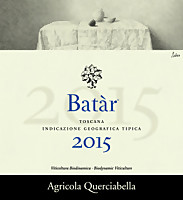
|
|
Batàr 2015 |
|
| Querciabella (Tuscany, Italy) | |
 Chardonnay, Pinot Bianco Chardonnay, Pinot Bianco | |
| Price: € 75.00 | Score: |
 Brilliant golden yellow and nuances of golden yellow, very transparent. Brilliant golden yellow and nuances of golden yellow, very transparent. Intense, clean, pleasing, refined and elegant, starts with hints of
banana, apple and acacia followed by aromas of pear, bergamot, plum,
grapefruit, butter, peach, honey, broom, praline, flint and vanilla. Intense, clean, pleasing, refined and elegant, starts with hints of
banana, apple and acacia followed by aromas of pear, bergamot, plum,
grapefruit, butter, peach, honey, broom, praline, flint and vanilla.
 Crisp attack and however balanced by alcohol, full body, intense
flavors, pleasing roundness. Crisp attack and however balanced by alcohol, full body, intense
flavors, pleasing roundness.
 Very persistent finish with long flavors of banana, apple and plum. Very persistent finish with long flavors of banana, apple and plum. Fermented in barrique, 9 months in barrique. Fermented in barrique, 9 months in barrique. |
|
 Roasted fish, Stuffed pasta with mushrooms, Roasted white meat, Stewed white meat Roasted fish, Stuffed pasta with mushrooms, Roasted white meat, Stewed white meat |
|
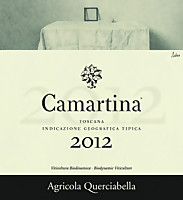
|
|
Camartina 2012 |
|
| Querciabella (Tuscany, Italy) | |
 Cabernet Sauvignon (70%), Sangiovese (30%) Cabernet Sauvignon (70%), Sangiovese (30%) | |
| Price: € 85.00 | Score: |
 Intense ruby red and nuances of garnet red, little transparency. Intense ruby red and nuances of garnet red, little transparency. Intense, clean, pleasing, refined and elegant, starts with hints of
black currant, plum and black cherry followed by aromas of blueberry,
violet, peony, face powder, cocoa, tobacco, blackberry, leather, licorice,
mace, vanilla and eucalyptus. Intense, clean, pleasing, refined and elegant, starts with hints of
black currant, plum and black cherry followed by aromas of blueberry,
violet, peony, face powder, cocoa, tobacco, blackberry, leather, licorice,
mace, vanilla and eucalyptus.
 Tannic attack and however balanced by alcohol, full body, intense
flavors, pleasing roundness. Tannic attack and however balanced by alcohol, full body, intense
flavors, pleasing roundness.
 Very persistent finish with long flavors of black currant, plum and
black cherry. Very persistent finish with long flavors of black currant, plum and
black cherry.
 24 months in barrique, 8 months in bottle. 24 months in barrique, 8 months in bottle. |
|
 Game, Stewed and braised meat, Roasted meat, Hard cheese Game, Stewed and braised meat, Roasted meat, Hard cheese |
|
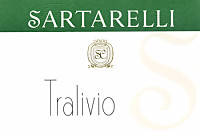
|
|
Verdicchio dei Castelli di Jesi Classico Superiore Tralivio 2016 |
|
| Sartarelli (Marches, Italy) | |
 Verdicchio Verdicchio | |
| Price: € 17.00 | Score: |
 Intense straw yellow and nuances of straw yellow, very transparent. Intense straw yellow and nuances of straw yellow, very transparent. Intense, clean, pleasing, refined and elegant, starts with hints of
apple, plum and hawthorn followed by aromas of pear, acacia, peach, citron,
broom, almond, pineapple, anise and mineral. Intense, clean, pleasing, refined and elegant, starts with hints of
apple, plum and hawthorn followed by aromas of pear, acacia, peach, citron,
broom, almond, pineapple, anise and mineral.
 Crisp attack and however balanced by alcohol, good body, intense
flavors, agreeable. Crisp attack and however balanced by alcohol, good body, intense
flavors, agreeable.
 Persistent finish with flavors of apple, plum and almond. Persistent finish with flavors of apple, plum and almond. Aged in steel tanks. Aged in steel tanks. |
|
 Broiled fish, Roasted white meat, Fish soups and mushrooms, Stuffed pasta Broiled fish, Roasted white meat, Fish soups and mushrooms, Stuffed pasta |
|
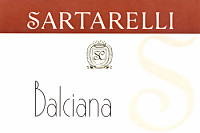
|
|
Verdicchio dei Castelli di Jesi Classico Superiore Balciana 2015 |
|
| Sartarelli (Marches, Italy) | |
 Verdicchio Verdicchio | |
| Price: € 38.00 | Score: |
 Intense golden yellow and nuances of golden yellow, very transparent. Intense golden yellow and nuances of golden yellow, very transparent. Intense, clean, pleasing, refined and elegant, starts with hints of
quince, medlar and hawthorn followed by aromas of pear, apple, beeswax,
linden, plum, apricot, chamomile, pineapple, mango, noble rot, almond and
mineral. Intense, clean, pleasing, refined and elegant, starts with hints of
quince, medlar and hawthorn followed by aromas of pear, apple, beeswax,
linden, plum, apricot, chamomile, pineapple, mango, noble rot, almond and
mineral.
 Crisp attack and however balanced by alcohol, full body, intense
flavors, pleasing roundness. Crisp attack and however balanced by alcohol, full body, intense
flavors, pleasing roundness.
 Very persistent finish with long flavors of quince, apricot and almond. Very persistent finish with long flavors of quince, apricot and almond. Aged in steel tanks. Aged in steel tanks. |
|
 Stuffed pasta with mushrooms, Roasted fish, Roasted white meat, Cheese Stuffed pasta with mushrooms, Roasted fish, Roasted white meat, Cheese |
|
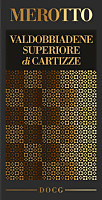
|
|
Valdobbiadene Superiore di Cartizze Dry 2017 |
|
| Merotto (Veneto, Italy) | |
 Glera Glera | |
| Price: € 19.00 | Score: |
 Brilliant greenish yellow and nuances of greenish yellow, very
transparent, fine and persistent perlage. Brilliant greenish yellow and nuances of greenish yellow, very
transparent, fine and persistent perlage.
 Intense, clean, pleasing and refined, starts with hints of pear, apple
and wisteria followed by aromas of peach, plum, jasmine, pineapple, broom
and hawthorn. Intense, clean, pleasing and refined, starts with hints of pear, apple
and wisteria followed by aromas of peach, plum, jasmine, pineapple, broom
and hawthorn.
 Effervescent attack with a pleasing sweetness, however balanced by
alcohol, light body, intense flavors, pleasing crispness. Effervescent attack with a pleasing sweetness, however balanced by
alcohol, light body, intense flavors, pleasing crispness.
 Persistent finish with flavors of pear, apple and peach. Persistent finish with flavors of pear, apple and peach. Fermented in closed tank for 50 days. Fermented in closed tank for 50 days. |
|
 Aperitifs, Crustacean appetizers, Sauteed crustaceans, Risotto with vegetables Aperitifs, Crustacean appetizers, Sauteed crustaceans, Risotto with vegetables |
|
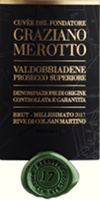
|
|
Valdobbiadene Prosecco Superiore Brut Rive di Col San Martino Cuvée del Fondatore Graziano Merotto 2017 |
|
| Merotto (Veneto, Italy) | |
 Glera Glera | |
| Price: € 19.00 | Score: |
 Pale straw yellow and nuances of greenish yellow, very transparent,
fine and persistent perlage. Pale straw yellow and nuances of greenish yellow, very transparent,
fine and persistent perlage.
 Intense, clean, pleasing, refined and elegant, starts with hints of
pear, peach and wisteria followed by aromas of pineapple, hawthorn, apple,
tangerine, kiwi, broom, plum and mineral. Intense, clean, pleasing, refined and elegant, starts with hints of
pear, peach and wisteria followed by aromas of pineapple, hawthorn, apple,
tangerine, kiwi, broom, plum and mineral.
 Effervescent and crisp attack, however balanced by alcohol, good body,
intense flavors, agreeable. Effervescent and crisp attack, however balanced by alcohol, good body,
intense flavors, agreeable.
 Persistent finish with flavors of pear, apple and peach. Persistent finish with flavors of pear, apple and peach. Fermented and aged in closed tanks for 6 months. Fermented and aged in closed tanks for 6 months. |
|
 Fish and crustacean appetizers, Sauteed crustaceans, Pasta and risotto with crustaceans Fish and crustacean appetizers, Sauteed crustaceans, Pasta and risotto with crustaceans |
|
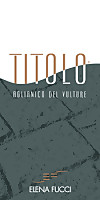
|
|
Aglianico del Vulture Titolo 2016 |
|
| Elena Fucci (Basilicata, Italy) | |
 Aglianico Aglianico | |
| Price: € 30.00 | Score: |
 Intense ruby red and nuances of ruby red, little transparency. Intense ruby red and nuances of ruby red, little transparency. Intense, clean, pleasing, refined and elegant, starts with hints of
black cherry, blackberry and plum followed by aromas of violet, geranium,
blueberry, raspberry, carob, pink pepper, cinnamon, mace, rosemary, vanilla
and menthol. Intense, clean, pleasing, refined and elegant, starts with hints of
black cherry, blackberry and plum followed by aromas of violet, geranium,
blueberry, raspberry, carob, pink pepper, cinnamon, mace, rosemary, vanilla
and menthol.
 Properly tannic attack and however balanced by alcohol, full body,
intense flavors, pleasing crispness. Properly tannic attack and however balanced by alcohol, full body,
intense flavors, pleasing crispness.
 Very persistent finish with long flavors of black cherry, blackberry
and plum. Very persistent finish with long flavors of black cherry, blackberry
and plum.
 12 months in barrique, 12 months in bottle. 12 months in barrique, 12 months in bottle. |
|
 Game, Roasted meat, Stewed and braised meat, Hard cheese Game, Roasted meat, Stewed and braised meat, Hard cheese |
|

|
|
Trento Dosaggio Zero Riserva Masetto Privé 2008 |
|
| Endrizzi (Trentino, Italy) | |
 Chardonnay Chardonnay | |
| Price: € 69.00 | Score: |
 Brilliant golden yellow and nuances of golden yellow, very transparent,
fine and persistent perlage. Brilliant golden yellow and nuances of golden yellow, very transparent,
fine and persistent perlage.
 Intense, clean, pleasing, refined and elegant, starts with hints of
mature banana, apple and plum followed by aromas of pear, bread crust,
praline, grapefruit, honey, candied fruits, butter, croissant, flint and
vanilla. Intense, clean, pleasing, refined and elegant, starts with hints of
mature banana, apple and plum followed by aromas of pear, bread crust,
praline, grapefruit, honey, candied fruits, butter, croissant, flint and
vanilla.
 Effervescent and crisp attack, however balanced by alcohol, good body,
intense flavors, pleasing roundness. Effervescent and crisp attack, however balanced by alcohol, good body,
intense flavors, pleasing roundness.
 Very persistent finish with long flavors of mature banana, plum and
grapefruit. Very persistent finish with long flavors of mature banana, plum and
grapefruit.
 Refermented in bottle and aged on its lees for at least 84 months. Refermented in bottle and aged on its lees for at least 84 months. |
|
 Stuffed pasta, Mushroom soups, Roasted white meat, Stewed meat, Roasted fish Stuffed pasta, Mushroom soups, Roasted white meat, Stewed meat, Roasted fish |
|

|
|
Gran Masetto 2013 |
|
| Endrizzi (Trentino, Italy) | |
 Teroldego Teroldego | |
| Price: € 40.00 | Score: |
 Deep ruby red and nuances of garnet red, little transparency. Deep ruby red and nuances of garnet red, little transparency. Intense, clean, pleasing, refined and elegant, starts with hints of
blackberry, plum and black cherry followed by aromas of violet, blueberry,
carob, chocolate, tobacco, cinnamon, leather, licorice, mace, pink pepper,
vanilla and menthol. Intense, clean, pleasing, refined and elegant, starts with hints of
blackberry, plum and black cherry followed by aromas of violet, blueberry,
carob, chocolate, tobacco, cinnamon, leather, licorice, mace, pink pepper,
vanilla and menthol.
 Tannic attack and however balanced by alcohol, full body, intense
flavors, pleasing roundness. Tannic attack and however balanced by alcohol, full body, intense
flavors, pleasing roundness.
 Very persistent finish with long flavors of blackberry, black cherry
and plum. Very persistent finish with long flavors of blackberry, black cherry
and plum.
 20 months in barrique, 6 months in bottle. 20 months in barrique, 6 months in bottle. |
|
 Game, Roasted meat, Stewed and braised meat, Hard cheese Game, Roasted meat, Stewed and braised meat, Hard cheese |
|

|
|
Farfalla Noir Collection Extra Brut |
|
| Ballabio (Lombardy, Italy) | |
 Pinot Nero Pinot Nero | |
| Price: € 20.00 | Score: |
 Brilliant straw yellow and nuances of straw yellow, very transparent,
fine and persistent perlage. Brilliant straw yellow and nuances of straw yellow, very transparent,
fine and persistent perlage.
 Intense, clean, pleasing, refined and elegant, starts with hints of
apple, bread crust and plum followed by aromas of pear, peach, pink
grapefruit, lemongrass, tangerine, yeast, butter, hawthorn, honey and
hazelnut. Intense, clean, pleasing, refined and elegant, starts with hints of
apple, bread crust and plum followed by aromas of pear, peach, pink
grapefruit, lemongrass, tangerine, yeast, butter, hawthorn, honey and
hazelnut.
 Effervescent and crisp attack, however balanced by alcohol, good body,
intense flavors, agreeable. Effervescent and crisp attack, however balanced by alcohol, good body,
intense flavors, agreeable.
 Very persistent finish with long flavors of apple, bread crust and
plum. Very persistent finish with long flavors of apple, bread crust and
plum.
 Refermented in bottle on its lees for at least 30 months. Refermented in bottle on its lees for at least 30 months. |
|
 Pasta with fish, Roasted white meat, Stewed fish with mushrooms, Broiled fish Pasta with fish, Roasted white meat, Stewed fish with mushrooms, Broiled fish |
|
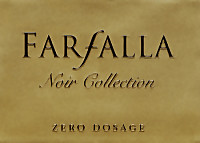
|
|
Farfalla Noir Collection Zero Dosage |
|
| Ballabio (Lombardy, Italy) | |
 Pinot Nero Pinot Nero | |
| Price: € 22.00 | Score: |
 Pale straw yellow and nuances of straw yellow, very transparent, fine
and persistent perlage. Pale straw yellow and nuances of straw yellow, very transparent, fine
and persistent perlage.
 Intense, clean, pleasing, refined and elegant, starts with hints of
apple, plum and bread crust followed by aromas of pear, raspberry,
grapefruit, tangerine, bergamot, hawthorn, yeast, butter, croissant, honey
and flint. Intense, clean, pleasing, refined and elegant, starts with hints of
apple, plum and bread crust followed by aromas of pear, raspberry,
grapefruit, tangerine, bergamot, hawthorn, yeast, butter, croissant, honey
and flint.
 Effervescent and crisp attack, however balanced by alcohol, good body,
intense flavors, agreeable. Effervescent and crisp attack, however balanced by alcohol, good body,
intense flavors, agreeable.
 Very persistent finish with long flavors of apple, grapefruit and
raspberry. Very persistent finish with long flavors of apple, grapefruit and
raspberry.
 Refermented in bottle and aged on its lees for at least 72 months. Refermented in bottle and aged on its lees for at least 72 months. |
|
 Pasta with fish, Roasted white meat, Stewed fish with mushrooms Pasta with fish, Roasted white meat, Stewed fish with mushrooms |
|
News |
|
In this section are published news and information about events concerning the world of wine and food. Whoever is interested in publishing this kind of information can send us a mail to our address.
|
AquavitaeReview of Grappa, Distillates and Brandy |
|
|
||||||||||||||
Wine Guide ParadeJune 2018
|
| |||||||
Privacy Policy | |||||||


| Copyright © 2002-2024 Antonello Biancalana, DiWineTaste - All rights reserved |
| All rights reserved under international copyright conventions. No part of this publication and of this WEB site may be
reproduced or utilized in any form or by any means, electronic or mechanical, without permission in writing from DiWineTaste. |